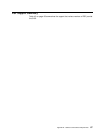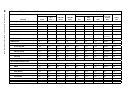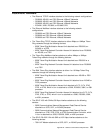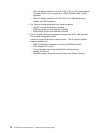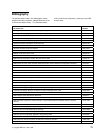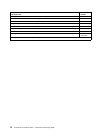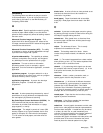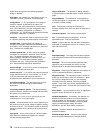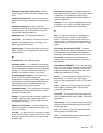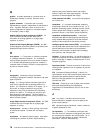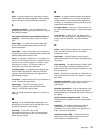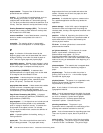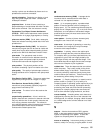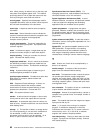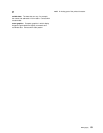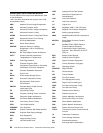Document Composition Facility (DCF). An IBM
licensed program that provides text formatting for the
3130.
double-byte character set. A type of character set
required to print unique characters, such as Japanese
Kanji.
double-byte coded font. A font in which the
characters are defined by two bytes; the first defines a
coded-font section, the second defines a code point.
Contrast with
single-byte coded font
.
double-byte font. See
double-byte coded font
.
drum count. The number of revolutions of the drum.
dry ink. The material that forms the image on the
paper. Synonymous with toner.
duplex printing. Printing on both sides of a sheet of
paper. Synonym for
two-sided printing
. Contrast with
simplex printing
.
E
electronic form. See
electronic overlay
.
electronic overlay. (1) A collection of constant data
that is electronically composed in the host system and
may be combined with variable data on a sheet during
printing. (2) The library member that contains the
definition of the electronic overlay. See
overlay
.
electrophotographic process. The creation of an
image on forms by uniformly charging the
photoconductor, creating an electrostatic image on the
photoconductor, attracting negatively charged toner to
the discharged areas of the photoconductor, and
transferring and fusing the toner to forms.
electrostatic image. The invisible image consisting of
discharged areas of the photoconductor as a result of
exposure from digital data.
emboss. To press and raise the surface of paper into
a design. Embossed paper appears thicker than
non-embossed paper, can increase printer wear, and
can degrade print quality.
Enhanced N_UP Printing. To divide a sheet into a
maximum of 8 partitions, anywhere on the sheet. See
also N_UP Printing.
error log. (1) A data set or file in a product or system
where error information is stored for later access. (2) A
record of machine checks, device errors, and volume
statistical data.
error-recovery procedure. Procedures designed to
help isolate and, where possible, to recover from errors
in equipment. The procedures are often used in
conjunction with programs that record the statistics of
machine malfunctions.
exception. (1) An invalid or unsupported data-stream
construction. (2) In IPDS, a condition requiring host
notification or requiring the host to resend data.
F
font. (1) A family or assortment of characters of a
given size and style; for example, 9-point Bodoni
modern. A font has a unique name and may have a
registry number. (2) A font is data used to create an
image of each graphic character; for example, a raster
pattern.
Font Library Service Facility (FLSF). A licensed
program that provides a way to make changes to a font
while retaining its correct format, as defined by the
architecture and as required by Print Services Facility.
font section. A subdivision of a double-byte font
character set. The section consists of a maximum of
256 characters.
form definition (FORMDEF). In Print Services Facility
(PSF), a resource object that defines the characteristics
of the form, which include: overlays to be used, text
suppression, position of page data on the form, and
number and modifications of a page.
format. (1) The arrangement or layout of data on a
data medium. (2) The size, style, type of page,
margins, printing requirements, and so on, of a printed
page.
forms. The material on which output data is printed,
such as paper or adhesive labels. See
electronic
overlay
and
preprinted form
.
forms path. The entire route that forms travel during
processing. The forms path usually begins where the
forms are loaded and ends at the stacker. Synonym for
paper path
.
forms overlay. In the 3130, that function of the printer
that allows customer-prepared data to be printed with
variable-page data.
fuse. To use heat and pressure to blend toner onto
forms to make a permanent bond.
fuser. The assembly that bonds the toned image to
the paper using heat and pressure.
Bibliography 77



